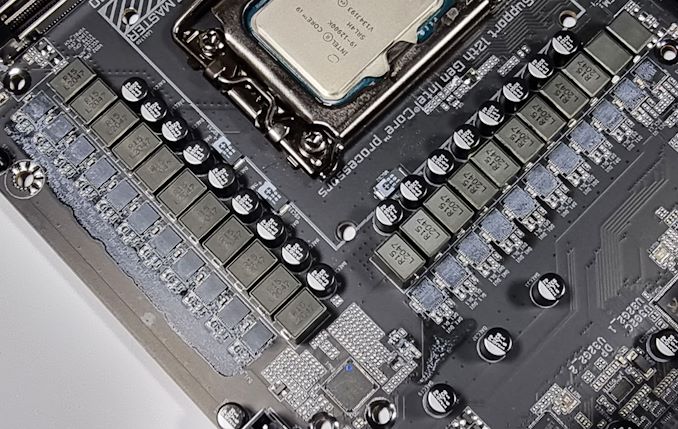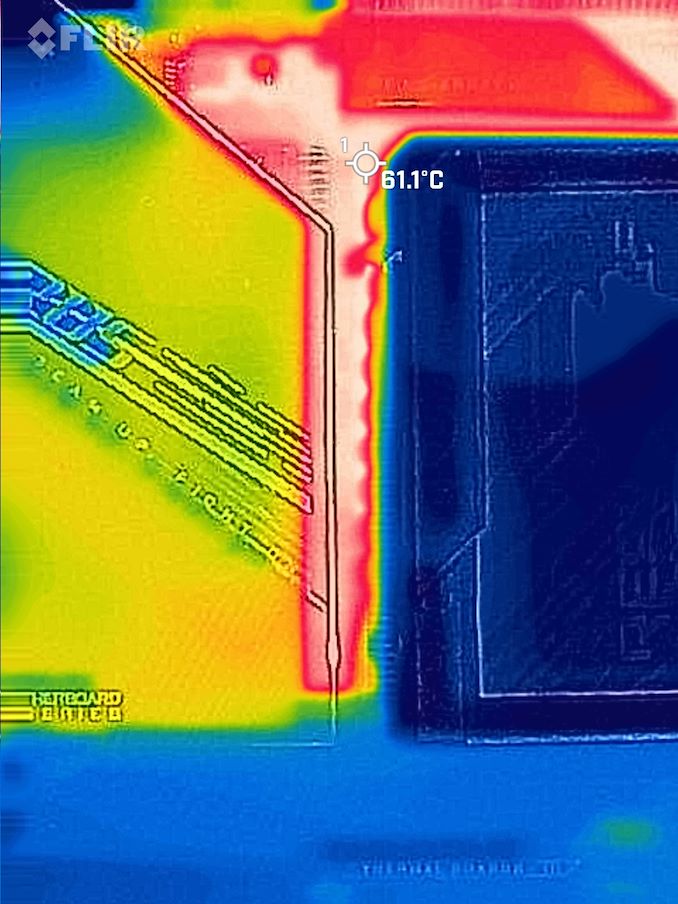The GIGABYTE Z690 Aorus Master Mobo Review: 10GbE Rounds Out A Premium Board
by Gavin Bonshor on February 25, 2022 9:00 AM ESTPower Delivery Thermal Analysis
One of the most requested elements of our motherboard reviews revolves around the power delivery and its componentry. Aside from the quality of the components and its capability for overclocking to push out higher clock speeds which in turn improves performance, is the thermal capability of the cooling solutions implemented by manufacturers. While almost always fine for users running processors at default settings, the cooling capability of the VRMs isn't something that users should worry too much about, but for those looking to squeeze out extra performance from the CPU via overclocking, this puts extra pressure on the power delivery and in turn, generates extra heat. This is why more premium models often include heatsinks on its models with better cooling designs, heftier chunks of metal, and in some cases, even with water blocks.

The 20-phase (19+1) power delivery on the GIGABYTE Z690 Aorus Master
Testing Methodology
Our method of testing is if the power delivery and its heatsink are effective at dissipating heat. We do this by running an intensely heavy CPU workload for a prolonged method of time. We apply an overclock, which is deemed safe and at the maximum that the silicon on our testbed processor allows. We then run the Prime95 with AVX2 enabled under a torture test for an hour at the maximum stable overclock we can, which puts insane pressure on the processor. We collect our data via three different methods which include the following:
- Taking a thermal image from a birds-eye view after an hour with a Flir Pro thermal imaging camera
- Securing two probes on to the rear of the PCB, right underneath CPU VCore section of the power delivery for better parity in case a probe reports a faulty reading
- Taking a reading of the VRM temperature from the sensor reading within the HWInfo monitoring application
The reason for using three different methods is that some sensors can read inaccurate temperatures, which can give very erratic results for users looking to gauge whether an overclock is too much pressure for the power delivery handle. With using a probe on the rear, it can also show the efficiency of the power stages and heatsinks as a wide margin between the probe and sensor temperature can show that the heatsink is dissipating heat and that the design is working, or that the internal sensor is massively wrong. To ensure our probe was accurate before testing, I binned 10 and selected the most accurate (within 1c of the actual temperature) for better parity in our testing.
To recreate a real-world testing scenario, the system is built into a conventional desktop chassis which is widely available. This is to show and alleviate issues when testing on open testbeds, which we have done previously, which allows natural airflow to flow over the power delivery heatsinks. It provides a better comparison for the end-user and allows us to mitigate issues where heatsinks have been designed with airflow in mind and those that have not. The idea of a heatsink is to allow effective dissipation of heat and not act as an insulator, with much more focus from consumers over the last couple of years on power delivery componentry and performance than in previous years.
For thermal imaging, we use a Flir One camera to indicate where the heat is generated around the socket area, as some designs use different configurations, and an evenly spread power delivery with good components will usually generate less heat. Manufacturers who use inefficient heatsinks and cheap out on power delivery components should run hotter than those who have invested. Of course, a $700 flagship motherboard is likely to outperform a cheaper $100 model under the same testing conditions, but it is still worth testing to see which vendors are doing things correctly.
Thermal Analysis Results

We measured 61.1ºC on the hottest part of the CPU socket during our testing
The GIGABYTE Z690 Aorus Master has a large 20-phase power delivery, which is controlled by a Renesas RAA229131 20-channel PWM controller that is operating in a 19+1 configuration. The CPU section includes nineteen Renesas 22010540 105 A power stages, while the SoC is using one Intersil 99390 90 A power stage. Keeping the power delivery cool is a large two-section metal heatsink that is interconnected by a single heat pipe. The heatsinks themselves feature multiple fins designed to direct the passive airflow to aid in heat dissipation.
Comparing the GIGABYTE Z690 Aorus Master against boards at a similar price point, it performs well in regard to power delivery thermals. Currently, the Z690 Aorus Master has the coolest power delivery of any Z690 board we've tested so far, and it is something GIGABYTE has been good at on its premium models over the last couple of years. We noted temperatures of 65°C from the integrated VRM sensor, as well as temperatures of 64°C and 66°C from our pair of K-type thermocouples.











35 Comments
View All Comments
megapleb - Friday, February 25, 2022 - link
"Still, one that aims to offer users something of a sweet spot for enthusiasts and gamers with a mixture of premium features and gaming-inspired aesthetics is the GIGABYTE Z690 Aorus Master."$490 is a sweet spot? I understand there are more expensive boards, but that's already a hell of a lot of money for a consumer motherboard. I think we have normalized way too high a price for "premium" motherboards.
timecop1818 - Friday, February 25, 2022 - link
There's no reason to spend more than 250-ish on a z690 board, like the MSI pro-a. this dumb thing covers up half the board with shitty heatsinks and makes working on a board already in case or swapping SSDs etc a real chore. and 10gb? lol, you can buy 10g sfp+ cards for like $40 on eBay.Samus - Sunday, February 27, 2022 - link
The audio implementation on this board is $100 alone. While $499 is a stretch, this is clearly a premium product with substantially more attention to detail than a $250 board that will likely have weaker VRM's, an ALC887, and definitely no 10Gbe.damianrobertjones - Monday, February 28, 2022 - link
Its' not £100 when the price is artificially created from thin air.Samus - Thursday, March 3, 2022 - link
Not sure what you are on about. The only thing artificially created from thin air is your statement. A quality audio solution on par with that integrated with this board is $100. That was my point.Tom Sunday - Tuesday, April 5, 2022 - link
Greetings from Stehekin, WA. Still enjoying high speed internet access at 25mbps Besides I would never appreciate the difference of 10Gbe under any circumstances. Almost $500 for any Z690 MB is insane I can simply not afford it like probably 95% of the viewers here. Realty and the 'man on the street' like me seems to be a totally forgotten segment seen at most tech-channels. As to thin air...the high mountain air here in Stehekin is indeed thin and super clean.firewrath9 - Monday, February 28, 2022 - link
Most people dont have fiber in their home. A 10 gbase-t card costs $75-100+lilkwarrior - Tuesday, March 1, 2022 - link
It's primarily for NAS and other high-end use cases.lilkwarrior - Tuesday, March 1, 2022 - link
*productive use cases.ddhelmet - Friday, February 25, 2022 - link
Just get a Z690-A PRO and a 10gig pci-e if you really want one. I just don't see the point of this board.